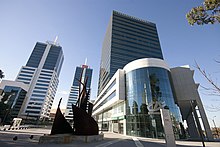
Back اقتصاد أوروغواي Arabic Economía d'Uruguái AST Эканоміка Уругвая Byelorussian Economia de l'Uruguai Catalan Economía de Uruguay Spanish Économie de l'Uruguay French Economía do Uruguai Galician Ուրուգվայի տնտեսություն Armenian Ekonomio di Uruguay IO 우루과이의 경제 Korean
 World Trade Center Montevideo | |
| Currency | Uruguayan peso (UYU, $U) |
|---|---|
| Calendar year | |
Trade organizations | WTO, ALADI, Mercosur, Andean Community (associate) |
Country group | |
| Statistics | |
| Population | |
| GDP | |
| GDP rank | |
GDP growth | |
GDP per capita | |
GDP per capita rank | |
GDP by sector |
|
Population below poverty line | |
| |
Labor force | |
Labor force by occupation |
|
| Unemployment | |
Main industries | food processing, electrical machinery, transportation equipment, petroleum products, textiles, chemicals, beverages |
| External | |
| Exports | |
Export goods | beef, soybeans, cellulose, rice, wheat, wood, dairy products, wool |
Main export partners |
|
| Imports | |
Import goods | refined oil, crude oil, passenger and other transportation vehicles, vehicle parts, cellular phones |
Main import partners |
|
FDI stock | |
Gross external debt | |
| Public finances | |
| −3.5% (of GDP) (2017 est.)[6] | |
| Revenues | 17.66 billion (2017 est.)[6] |
| Expenses | 19.72 billion (2017 est.)[6] |

The economy of Uruguay features an export-oriented agricultural sector and a well-educated workforce, along with high levels of social spending. Tourism and banking are also prominent sectors; Uruguay acts as a regional hub for international finance and tourism. The country also has a history and representation of advanced workers-rights protection, with unions and the eight-hour work-day protected at the beginning of the 20th century.
90% of the country's population is urbanized, while most of the industry and over half of the population is concentrated in the capital Montevideo.[15]
After averaging growth of 5% annually during 1996–98, Uruguay's economy suffered a major downturn in 1999–2002, stemming largely from the spillover effects of the economic problems of its large neighbors; Argentina and Brazil. In 2001–02, Argentine citizens made massive withdrawals of dollars deposited in Uruguayan banks after bank deposits in Argentina were frozen, which led to a plunge in the Uruguayan peso, causing the 2002 Uruguay banking crisis.
- ^ "World Economic Outlook Database, April 2019". IMF.org. International Monetary Fund. Retrieved 29 September 2019.
- ^ "World Bank Country and Lending Groups". datahelpdesk.worldbank.org. World Bank. Retrieved 29 September 2019.
- ^ "Population, total - Uruguay". data.worldbank.org. World Bank. Retrieved 5 December 2019.
- ^ a b c d "Report for Selected Countries and Subjects: April 2024". imf.org. International Monetary Fund.
- ^ a b c "The outlook is uncertain again amid financial sector turmoil, high inflation, ongoing effects of Russia's invasion of Ukraine, and three years of COVID". International Monetary Fund. April 11, 2023.
- ^ a b c d e f g h i j k l m n o "The World Factbook". CIA.gov. Central Intelligence Agency. Retrieved 28 January 2019.
- ^ "Índice de Precios del Consumo (IPC)". Instituto Nacional de Estadística. 2024-05-03. Retrieved 2024-05-05.
- ^ "Uruguay ratifica baja de la pobreza en el último año". ine.gub.uy (in Spanish). Instituto Nacional de Estadística. 2023-03-27. Retrieved 2024-05-05.
- ^ "GINI index (World Bank estimate) - Uruguay". data.worldbank.org. World Bank. Retrieved 21 March 2020.
- ^ a b "Human Development Report 2023/2024" (PDF). United Nations Development Programme. 13 March 2024. Archived (PDF) from the original on 13 March 2024. Retrieved 17 April 2024.
- ^ "Labor force, total - Uruguay". data.worldbank.org. World Bank. Retrieved 27 April 2021.
- ^ a b "Actividad, Empleo y Desempleo". ine.gub.uy. Instituto Nacional de Estadística. Retrieved 27 April 2021.
- ^ "Sovereigns rating list". Standard & Poor's. Retrieved 26 May 2011.
- ^ a b c Rogers, Simon; Sedghi, Ami (15 April 2011). "How Fitch, Moody's and S&P rate each country's credit rating". The Guardian. London. Retrieved 28 May 2011.
- ^ Cite error: The named reference
:0was invoked but never defined (see the help page).
Cite error: There are <ref group=note> tags on this page, but the references will not show without a {{reflist|group=note}} template (see the help page).
© MMXXIII Rich X Search. We shall prevail. All rights reserved. Rich X Search